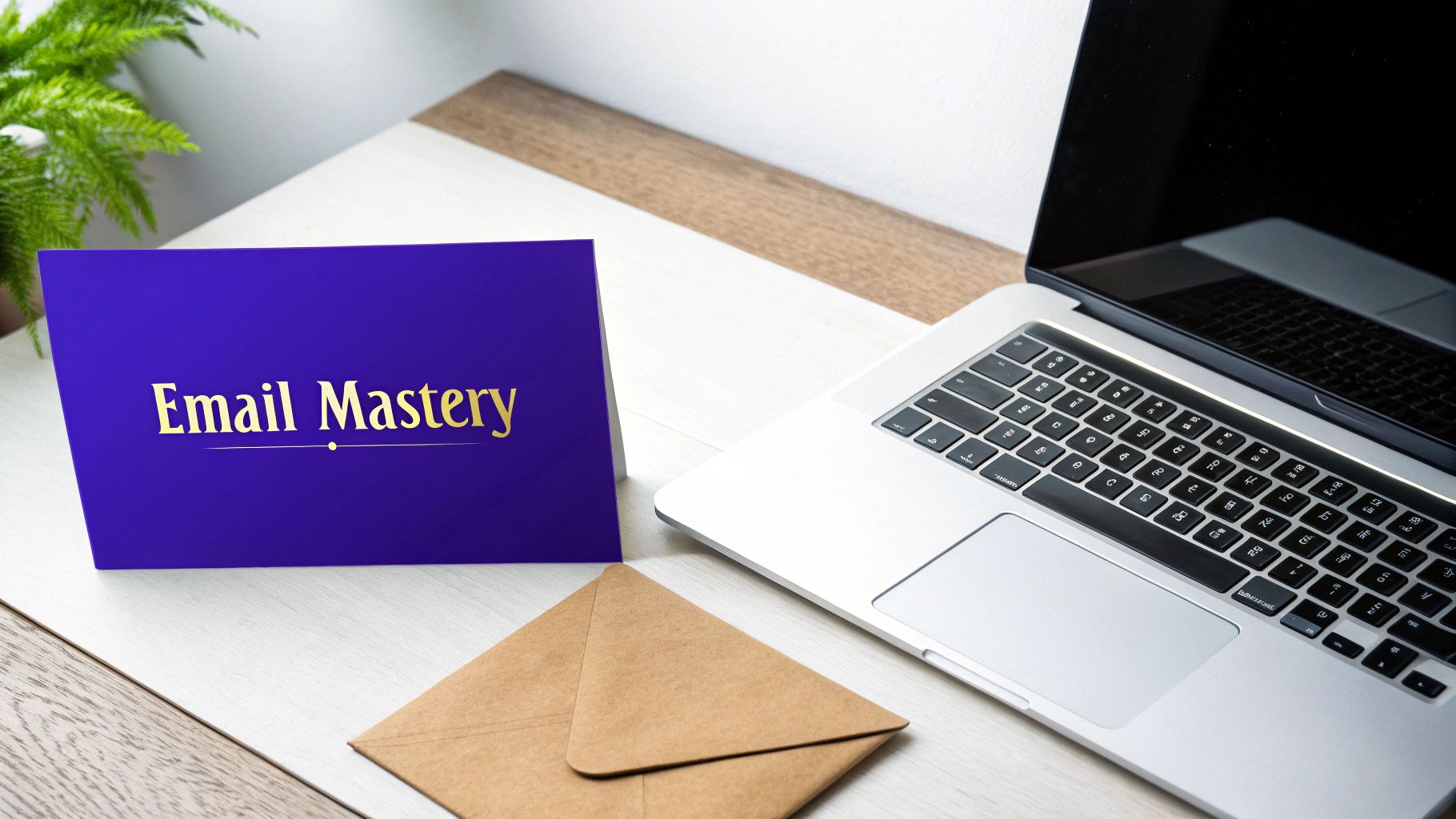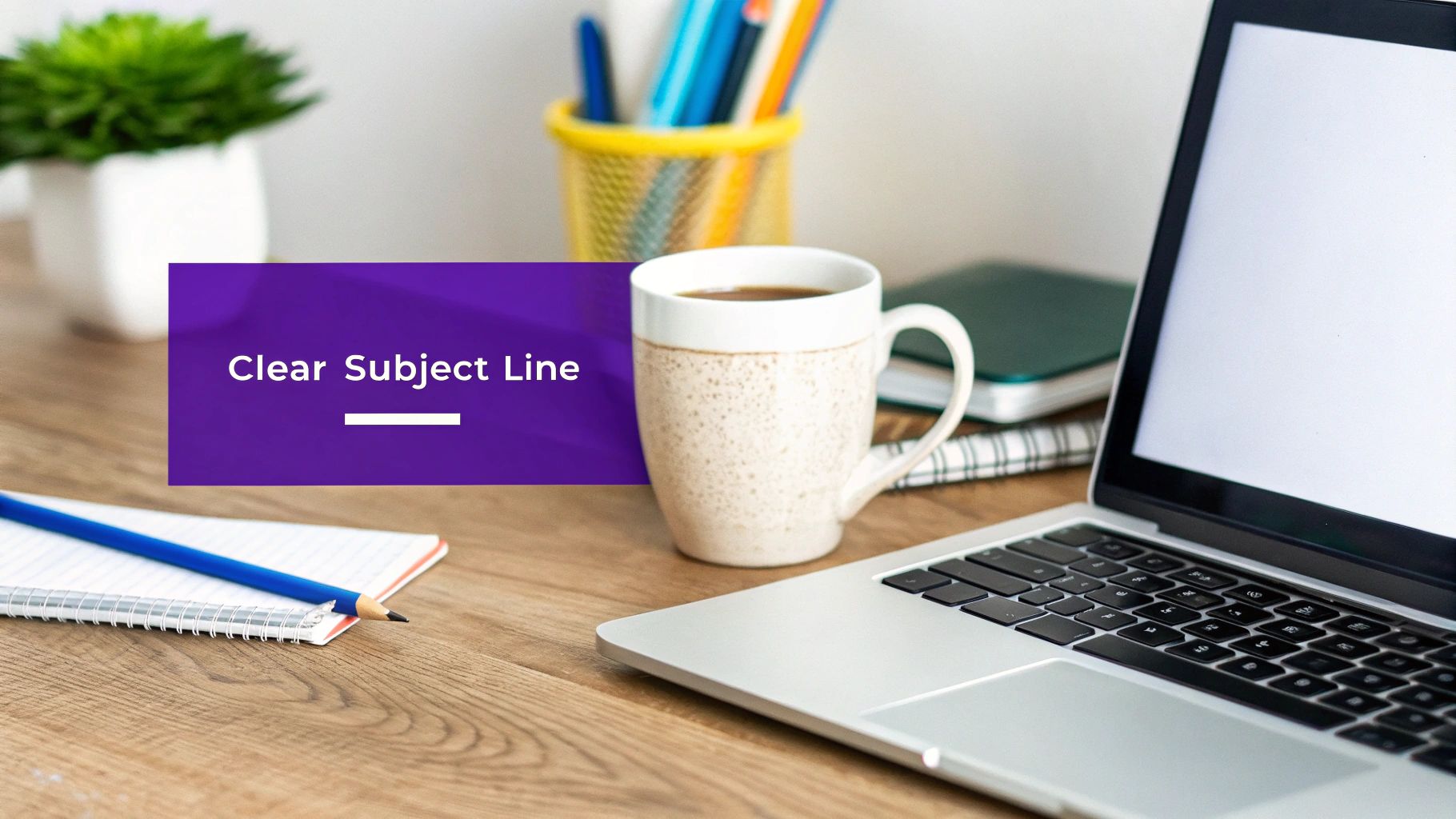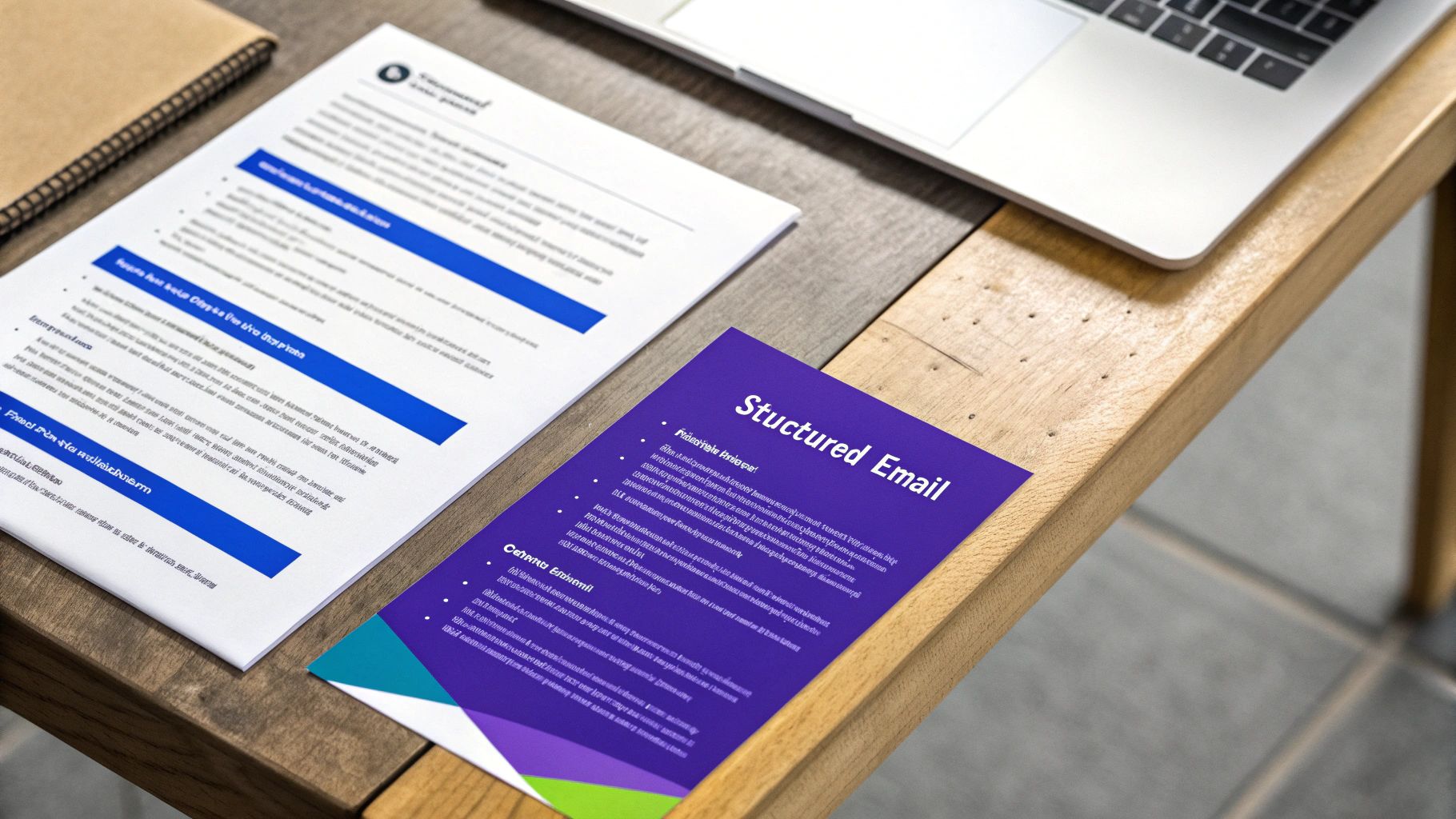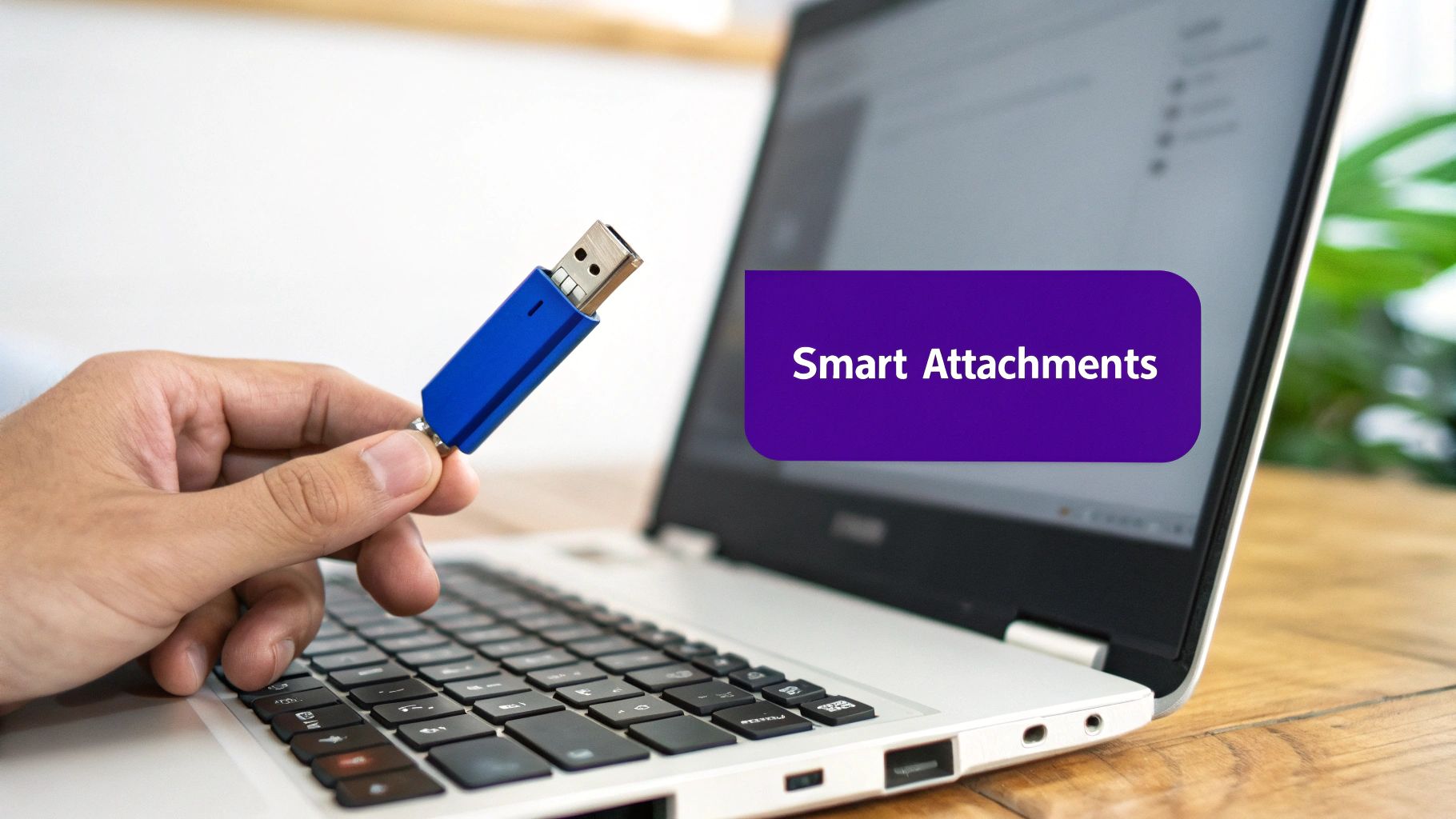Top Professional Email Etiquette Tips for 2025
Unlock the secrets to effective email communication with our comprehensive guide on professional email etiquette. Learn how to craft compelling subject lines, use proper salutations, maintain a professional tone, and more. Master these skills to enhance your professionalism and achieve your communication goals.

Elevate Your Email Game: Essential Etiquette for 2025
This listicle delivers seven actionable professional email etiquette tips to enhance your communication and avoid common pitfalls. Mastering these concepts is crucial for building relationships and conveying information effectively. Learn how to craft clear subject lines, use proper salutations, maintain a professional tone, structure emails strategically, manage CC and BCC, optimize response times, and handle attachments like a pro. Following these professional email etiquette tips will ensure your messages project professionalism and make a positive impact.
1. Crafting Clear and Concise Subject Lines
Subject lines are the gatekeepers of your email. They serve as the first impression and significantly influence whether recipients open your message, making them a crucial element of professional email etiquette tips. A well-crafted subject line concisely and accurately reflects the email's content, allowing recipients to quickly grasp the purpose and prioritize accordingly. This directly impacts your email open rates and overall communication effectiveness. A vague or misleading subject line can lead to your email being overlooked, deleted, or even flagged as spam.

This critical component of professional email etiquette typically uses 5-7 words, employs action-oriented phrasing, and provides specific information about the email's content. Avoid using all caps, excessive punctuation, or misleadingly urgent phrasing. For example, instead of a generic subject like "Project Update," a more effective subject line would be "Q3 Report Draft for Review by 5/15." This improved version clearly states the topic (Q3 Report Draft), the required action (Review), and the deadline (5/15). Other examples include "Meeting Request: Budget Planning - May 20" or "Action Required: Client Contract Approval." Even a simple "Quick Question About Project Timeline" provides enough context for the recipient to gauge the email's purpose.
The benefits of concise and informative subject lines are numerous. They increase email open rates, enabling your message to reach its intended audience. They also help recipients prioritize their often overflowing inboxes, ensuring important communications are addressed promptly. Furthermore, clear subject lines facilitate email organization and searchability, making it easier to locate specific messages later. Finally, they set clear expectations for the email's content, reducing the likelihood of misunderstandings.
However, crafting the perfect subject line can be challenging. It requires balancing brevity with sufficient information to be meaningful. Mastering this skill may take practice and conscious effort. Cultural differences can also influence how subject lines are interpreted, so consider your audience when writing. Finally, subject line strategies may need to be adjusted depending on the recipient and the specific context of the communication.
Tips for Writing Effective Subject Lines:
- Front-load the most important words: Place keywords at the beginning for immediate impact.
- Include deadlines when applicable: Clearly communicate urgency with specific due dates.
- Use standardized prefixes: For recurring communications, use prefixes like "[ACTION]" or "[FYI]" for easy filtering.
- Review and edit: Always double-check your subject line for clarity and accuracy before sending.
- Avoid overuse of "URGENT": Reserve this for genuinely time-sensitive matters to maintain its impact.
This aspect of professional email etiquette is particularly relevant for Business Professionals, Sales and Marketing Teams, Customer Support Staff, Freelancers and Entrepreneurs, and Event Organizers, all of whom rely heavily on email for effective communication. By mastering the art of the concise and informative subject line, you can significantly enhance your communication efficiency and professionalism. Learn more about Crafting Clear and Concise Subject Lines to further refine your skills.
2. Proper Salutations and Closings
In the realm of professional email etiquette tips, mastering proper salutations and closings is paramount. These elements frame your message, setting the tone, level of formality, and context of your relationship with the recipient. They act as crucial first and last impressions, demonstrating respect and attention to detail. Choosing the right salutation and closing can significantly influence how your message is received and interpreted, ultimately impacting its effectiveness. A well-chosen opening and closing contribute to clear, professional communication and foster a positive perception of you and your organization.

One of the key features of effective salutations and closings is their adaptability. The level of formality should align with your relationship with the recipient. A formal "Dear Dr. Johnson," paired with "Sincerely," is appropriate for initial contact or a hierarchical difference. A semi-formal "Hello Sarah," with "Best regards," suits established professional connections. Within teams or with close colleagues, "Hi Team," followed by "Thanks," or "Cheers," may be acceptable. Furthermore, the salutation and closing can evolve with the ongoing correspondence, reflecting the developing relationship.
Cultural sensitivity is another vital aspect of this professional email etiquette tip. Different cultures have varying norms around greetings. Researching these norms when communicating internationally demonstrates respect and avoids potential misunderstandings. Consistency with organizational culture is also important; observe how colleagues within your company address each other and external contacts.
Pros of Using Proper Salutations and Closings:
- Establishes Appropriate Tone Immediately: The opening sets the stage for the entire email, conveying the intended formality and purpose.
- Demonstrates Professionalism and Attention to Detail: A well-crafted salutation and closing reflects positively on your professionalism and attention to detail.
- Builds Rapport Through Personalization: Addressing the recipient appropriately and using personalized closings can foster a sense of connection.
- Provides Structure to Communications: These elements frame the email, creating a clear beginning and end, improving readability and comprehension.
Cons of Improper Usage:
- Inappropriate Choices Can Create Negative Impressions: An overly casual or overly formal approach can be misconstrued, damaging your credibility.
- May Require Research for International Correspondence: Navigating cultural differences can require extra effort and research.
- Can Feel Formulaic if Not Personalized: Generic greetings can feel impersonal; tailor them to the specific recipient and context whenever possible.
- Might Need Frequent Adjustments as Relationships Evolve: As relationships develop, the level of formality may shift, requiring adjustments to salutations and closings.
Examples of Effective Salutations and Closings:
- Formal: "Dear Dr. Johnson," with "Sincerely," or "Kind regards,"
- Semi-formal: "Hello Sarah," with "Best regards," or "Thank you,"
- Established relationship: "Hi Team," with "Thanks," or "Cheers,"
- Follow-up emails: "As discussed..." with "Looking forward to your response,"
Actionable Tips for Implementation:
- Default to more formal salutations with new contacts.
- Research cultural norms for international recipients.
- Mirror the recipient's level of formality.
- Include the recipient's title (Dr., Professor) when applicable.
- Avoid overly casual greetings ("Hey") in professional settings.
- Set up email signature templates for consistent closings.
This aspect of professional email etiquette deserves a prominent place on this list because it directly influences how your message is perceived and the impression you make. Mastering this skill enhances your professional communication, builds stronger relationships, and contributes to achieving your communication goals. Whether you're a business professional, part of a sales team, involved in customer support, a freelancer, or an event organizer, adhering to these professional email etiquette tips regarding salutations and closings will significantly improve your communication effectiveness.
3. Professional Tone and Language
Professional tone and language in emails are crucial for conveying credibility, competence, and emotional intelligence. This aspect of email etiquette directly impacts how your message is received and interpreted, influencing the effectiveness of your communication and the strength of your professional relationships. A balanced, positive, and clear communication style helps avoid misinterpretations and fosters productive interactions. Maintaining appropriate formality while still sounding personable is the key to achieving effective business communication. This means choosing words and phrasing that are respectful, considerate, and appropriate for a professional context.

This element of professional email etiquette deserves a prominent place on this list because it underpins all other best practices. Even if you perfectly format your email and use a clear subject line, if the tone is unprofessional, your message can be easily misconstrued. The core features of professional tone and language include clear and concise wording, a positive or neutral framing of requests and responses, the avoidance of slang, jargon, and emoticons in formal settings, impeccable grammar and spelling, and an appropriate level of detail. For example, instead of using technical jargon that your recipient may not understand, provide clear explanations or define technical terms in an appendix, as in: "I've attached the analysis (with technical terms defined in the appendix)."
Implementing professional tone and language offers several advantages. It reduces the chances of misunderstanding, projects professionalism and competence, builds trust and credibility, and creates a written record with an appropriate tone that can be referred to later. Conversely, an overly formal tone can sometimes come across as impersonal, and crafting carefully worded emails can require more time and effort. Tone can also be difficult to convey accurately in written form, and cultural and generational differences can further affect its perception. For example, while "I'm flexible and can accommodate your schedule." is generally a professional response, certain cultural contexts may prefer more specific time commitments. Learn more about Professional Tone and Language for further insights.
To effectively employ professional tone and language, consider these actionable tips: Read emails aloud before sending to ensure the tone conveys your intended message. Use active voice for clarity and directness. Avoid humor that could be misinterpreted, especially in cross-cultural communication. Always include sufficient context and specific details so your message is easily understood. Be mindful of cultural differences in communication styles. Use tools like Grammarly to check your writing for tone and clarity. Finally, and perhaps most importantly, wait before sending emotionally charged responses to allow for a more measured and professional reply. Instead of firing off a quick "You didn't send the report," take a breath and try a more diplomatic approach: "I don't see the report in my inbox. Could you please resend it?" This seemingly small change in phrasing can make a significant difference in how your message is received. This advice has been popularized by various sources, including Harvard Business Review's communication guidelines, Barbara Pachter's business etiquette books, and Google's digital communication training. By mastering professional tone and language, you will enhance your communication effectiveness and cultivate stronger professional relationships.
4. Strategic Email Structure and Formatting
In the realm of professional email etiquette tips, strategic structure and formatting play a crucial role. Well-structured emails demonstrate respect for recipients' time by presenting information efficiently and ensuring key takeaways are easily understood. This involves organizing content logically, using appropriate paragraph lengths, and incorporating visual elements that enhance readability. Ultimately, a thoughtful email structure increases the likelihood of prompt and complete responses, making it a cornerstone of effective communication.

This approach prioritizes the inverted pyramid structure, placing the most important information upfront. This caters to busy professionals who often scan emails quickly. Supporting details and background information follow, allowing readers to delve deeper if necessary. Key features of this method include: bulleted or numbered lists for multiple points, strategic use of white space, consistent font type and size, and the use of bold or italic formatting for emphasis. Paragraphs are kept concise, ideally within 3-5 sentences, to improve readability.
This method offers several benefits. It improves information retention and comprehension by presenting information in a digestible format. By clearly outlining requests and questions, it increases the chances of receiving complete answers. The scannable nature of well-structured emails is particularly beneficial for busy professionals. Overall, it projects an image of organization and thoughtful preparation, enhancing your professional credibility.
However, there are some potential drawbacks to consider. Structuring emails strategically may require more upfront time and effort compared to writing a quick, informal message. Furthermore, some email clients may alter formatting, potentially disrupting the intended layout. For very simple communications, this structured approach might feel overly formal. Finally, applying this method to complex topics can be challenging, requiring careful planning and organization.
Several successful examples demonstrate the effectiveness of strategic email structuring. McKinsey's SCQA framework (Situation, Complication, Question, Answer) provides a clear and concise way to frame complex problems and propose solutions. Amazon's internal "six-pager" memo, adapted for email, offers a robust structure for in-depth analyses. A simple yet effective technique is to open with a clear statement of purpose, such as "I'm writing about X," followed by specific action items. Google's structured approach, which often includes background, recommendations, and next steps, is another excellent example.
To effectively implement strategic email structuring, consider these actionable tips: State the purpose of your email in the first sentence. Use headlines or subheadings for different sections in longer emails. Keep paragraphs under 5 lines for improved readability. Bold action items or deadlines to ensure they stand out. Number questions requiring responses for clarity. For complex information, provide a brief summary statement upfront to prepare the reader. Use a single space after periods for a clean look. Finally, always test the appearance of your emails on different devices, particularly mobile, to ensure consistent formatting.
This principle is popularized by Barbara Minto's Pyramid Principle, Nielsen Norman Group's web usability research, and Jeff Bezos's memo approach at Amazon, demonstrating its widespread acceptance in professional communication.
Strategic email structure and formatting deserves a prominent place in any list of professional email etiquette tips due to its profound impact on communication effectiveness. It bridges the gap between the sender's intent and the recipient's understanding, ultimately leading to clearer communication, faster responses, and stronger professional relationships. This is particularly beneficial for business professionals, sales and marketing teams, customer support staff, freelancers, entrepreneurs, and event organizers, all of whom rely heavily on email for effective communication.
5. Strategic Use of CC, BCC, and Reply All
Mastering the CC, BCC, and Reply All functions is crucial for professional email etiquette. These tools, while seemingly simple, significantly impact information distribution, transparency, accountability, and workflow efficiency. Their strategic use demonstrates email proficiency and strengthens communication, while misuse can lead to productivity drains and privacy breaches. This element of email etiquette is therefore essential for anyone striving for professionalism in their digital communications.
Understanding the Mechanics:
CC (Carbon Copy): This function sends a copy of the email to the listed recipients. Everyone included in the email chain can see the CC'd addresses. CC is appropriate when someone needs to be kept informed, but direct action isn't required from them.
BCC (Blind Carbon Copy): This function also sends a copy of the email, but the BCC'd addresses are hidden from all other recipients. This is essential for protecting privacy when sending mass emails or when recipients don't know each other.
Reply All: This function sends a reply to everyone included in the original email's "To," "CC," and sometimes "BCC" fields (depending on the email client). It's useful for keeping everyone on the same page, but overuse can lead to cluttered inboxes.
Illustrative Examples:
CC for Visibility: CC'ing your manager on an email thread with a client keeps them informed of the communication and progress without requiring their direct involvement.
BCC for Privacy: When sending a newsletter or an announcement to a large list of clients, use BCC to protect their email addresses from being exposed to each other.
Reply All for Team Alignment: When a project team makes a key decision via email, using Reply All ensures everyone is aware of the outcome and any agreed-upon next steps.
Strategic CC for Responsibility Shift: Moving a recipient from the "To" line to "CC" can subtly indicate a shift in responsibility. This signals that they are no longer the primary point of contact but should still be kept in the loop.
Actionable Tips for Effective Use:
CC Wisely: Only include recipients in the CC field who genuinely need to be aware of the communication, not those who require action.
BCC for Mass Communication: BCC is crucial for protecting recipient privacy when sending mass emails. Consider mentioning in the email body that others have been BCC'd for transparency.
Double-Check Before Hitting Reply All: Pause and consider who truly needs to see your response before clicking Reply All. Setting up confirmation prompts for Reply All in your email settings can prevent accidental mass replies.
Manage Recipient Lists Actively: Remove recipients from email chains when the topic no longer concerns them. This helps keep inboxes clear and prevents information overload.
Transparency with BCC: If using BCC, consider briefly mentioning in the email body that other recipients have been included but their addresses are hidden for privacy.
Benefits and Drawbacks:
Pros:
- Ensures all stakeholders have the necessary information.
- Creates transparency and documentation when needed.
- Protects recipient privacy with BCC.
- Facilitates efficient communication workflows.
- Improves accountability tracking.
Cons:
- Overuse can lead to email overload and decreased productivity.
- Misuse, particularly with BCC, can cause privacy breaches.
- Reply All accidents can be embarrassing or damaging.
- CC'ing too many people creates an expectation of response, potentially leading to confusion and inefficiency.
Influence and Best Practices:
The importance of strategic CC, BCC, and Reply All usage has been highlighted by corporate email policies at major companies like IBM and Microsoft. Cal Newport's concepts in "A World Without Email" underscore the need for mindful communication practices to reduce digital overload, including judicious use of these email features. Furthermore, privacy regulations such as GDPR have significantly influenced email practices, emphasizing the responsible handling of recipient information, particularly when using BCC.
By adhering to these professional email etiquette tips regarding CC, BCC, and Reply All, you can improve communication efficiency, protect privacy, and contribute to a more productive and respectful digital work environment.
6. Responsiveness and Response Management
In the realm of professional email etiquette tips, responsiveness and response management hold a critical position. This element balances the need for timely communication with the realities of workload management. It's about establishing clear expectations regarding your availability and reliability, all while maintaining professional boundaries. Effective response management encompasses acknowledgment strategies, prioritization frameworks, and setting appropriate expectations that respect both the sender's and recipient's needs. This is crucial for business professionals, sales and marketing teams, customer support staff, freelancers, entrepreneurs, and event organizers alike, as efficient email communication is paramount to success in these roles.
Responsiveness isn't about instantly replying to every email; it's about managing communication effectively. This involves acknowledging receipt, prioritizing messages, and providing realistic timelines for a full response. Features of a robust response management system include defined response time expectations by message type (e.g., urgent requests vs. general inquiries), established acknowledgment protocols, auto-responders for absences, prioritization systems (such as flagging or categorizing emails), and expectation management tools.
Several benefits arise from implementing a structured approach to email responsiveness. It builds a reputation for reliability and reduces anxiety for senders awaiting responses. Clear communication channels are created, preventing miscommunications and the need for excessive follow-up emails. However, striving for constant responsiveness can also create pressure for immediate replies, potentially setting unsustainable precedents if you become too responsive. Maintaining such a system requires discipline and adapting to differing cultural expectations regarding communication can be challenging.
Successful implementations of response management can be seen in various organizations. Google's email management approach encourages batch processing, dedicating specific times for handling emails rather than constant interruptions. A quick acknowledgment like, "Got this - will review and respond by Thursday," sets a clear expectation. Microsoft's RAPID decision-making framework can be adapted for email responses, ensuring clarity on roles and responsibilities in responding. Patagonia's communication policy, emphasizing after-hours boundaries, demonstrates a commitment to healthy work-life balance.
Here are some actionable tips for enhancing your email responsiveness:
- Acknowledge receipt of important emails: Even if you can't provide a full response immediately, a brief acknowledgment assures the sender their message has been received.
- Out-of-office responder: Set up an informative out-of-office reply when unavailable, indicating when you'll return and who to contact for urgent matters.
- The 2-minute rule: If responding takes less than two minutes, do it immediately. This clears small tasks quickly.
- Templates for common responses: Save time by creating templates for frequently sent emails.
- Expected response times: State your typical response time in your email signature to manage expectations proactively.
- Scheduled email processing: Dedicate specific times for checking and responding to emails to avoid constant distractions.
- Reasonable deadlines: Set realistic response deadlines in your requests to others.
- Prioritize with flags/categories: Use email flags or categories to prioritize responses based on urgency and importance.
These strategies are popularized by productivity methodologies such as David Allen's Getting Things Done, time management expert Julie Morgenstern, Cal Newport's deep work philosophy, and Jason Fried's approach at Basecamp. They all emphasize the importance of mindful communication and efficient workflow.
Learn more about Responsiveness and Response Management to delve deeper into the nuances of email communication.
By implementing these professional email etiquette tips and thoughtfully managing your responses, you can cultivate stronger professional relationships, enhance your productivity, and project an image of reliability and competence. This item deserves its place on the list because effective response management is fundamental to successful communication in today's fast-paced business environment.
7. Appropriate Attachment and Link Handling
Effective communication hinges on clarity and efficiency, especially in the professional realm. Appropriate attachment and link handling is a crucial element of professional email etiquette tips, directly impacting how your message is received and acted upon. It demonstrates technical proficiency and respect for recipients' time and resources, contributing significantly to a positive professional image. This practice involves securely and efficiently sharing supplementary materials, ensuring recipients can access the information without technical hurdles.
This aspect of email etiquette encompasses several key features:
- File size optimization: Reducing file sizes through compression or alternative sharing methods prevents emails from bouncing and respects recipients' inbox space.
- Secure sharing protocols: Utilizing encryption and secure file transfer services protects sensitive information and maintains confidentiality.
- Descriptive file naming: Clear and consistent file names (e.g., "ProjectAlpha_Proposal_20240308_v1.pdf") enable easy identification and organization.
- Format compatibility considerations: Choosing universally accessible formats like PDF ensures recipients can view the document regardless of their software.
- Alternative sharing options: Utilizing cloud storage links (Dropbox, Google Drive, OneDrive) offers a streamlined approach for large files and facilitates collaboration.
- Preview capabilities: Checking attachments before sending allows you to verify the correct file and identify potential formatting issues.
Why this matters: Providing comprehensive information efficiently strengthens your message. Documents, presentations, and other supporting materials often provide essential context. Proper attachment handling ensures these materials enhance your communication rather than hindering it.
Pros:
- Provides comprehensive information efficiently: Supplements the email body with detailed data.
- Creates documentation and reference materials: Facilitates organized record-keeping.
- Enables detailed sharing without cluttering email body: Keeps emails concise and focused.
- Facilitates collaboration on complex documents: Enables efficient co-authoring and feedback processes.
Cons:
- Can create security risks if mishandled: Sensitive data requires secure transfer methods.
- Large attachments may bounce or clog recipients' inboxes: Requires file size management strategies.
- Format compatibility issues between systems: Choosing universal formats mitigates this risk.
- May create version control problems: Cloud-based collaboration tools can address this concern.
Examples of Successful Implementation:
- Converting a Word document to a PDF before sending to ensure formatting consistency across different operating systems and devices.
- Using Dropbox or Google Drive links instead of attaching large files directly to the email.
- Adhering to naming conventions like "ProjectName_DocumentType_Date_Version.pdf" for clear identification.
- Employing security protocols, such as encryption, when sending sensitive financial documents, as practiced by major banks.
Actionable Tips for Effective Attachment Handling:
- Always mention attachments in the email body: Alert recipients to the presence and purpose of attached files.
- Keep attachments under 10MB when possible: Larger files should be shared via cloud storage links.
- Use descriptive file names including dates and versions: Enhance organization and prevent confusion.
- Convert to PDF for final documents to preserve formatting: Ensure consistent presentation across platforms.
- Consider cloud storage links for large files: Streamlines access and avoids clogged inboxes.
- Compress (zip) multiple files before sending: Simplifies transfer and reduces file size.
- Scan attachments for viruses before sending: Protects both you and your recipients.
- Preview the attachment to ensure it opens correctly: Catches errors before they reach the recipient.
- Use secure transfer methods for confidential information: Prioritize data security and compliance.
This element of email etiquette is increasingly emphasized by industry best practices, including enterprise file security standards (ISO 27001), Google Workspace file sharing practices, and Microsoft's secure attachment handling guidelines. By adhering to these professional email etiquette tips, you present yourself as technically proficient, organized, and respectful of your recipients' time and resources, ultimately fostering clearer and more effective communication.
7 Key Tips Comparison Guide
| Tip Title | Implementation Complexity 🔄 | Resource Requirements ⚡ | Expected Outcomes 📊 | Ideal Use Cases 💡 | Key Advantages ⭐ |
|---|---|---|---|---|---|
| Crafting Clear and Concise Subject Lines | Low to Moderate - requires writing skill and recipient understanding | Minimal - time investment and creativity | Higher open rates, better inbox prioritization | All outbound emails aiming to capture attention quickly | Improves open rates, sets expectations, aids organization |
| Proper Salutations and Closings | Low - easy to apply but needs cultural awareness | Minimal - knowledge of formality levels | Establishes tone and professionalism | Formal and semi-formal emails, evolving relationships | Sets tone, shows respect, builds rapport |
| Professional Tone and Language | Moderate - requires careful wording and review | Moderate - time for drafting and revising | Clear communication, reduces misunderstandings | Complex or sensitive communications requiring clarity | Enhances credibility, reduces misinterpretation |
| Strategic Email Structure and Formatting | Moderate to High - involves planning and formatting skills | Moderate - time to organize and format | Improved comprehension, increased response rates | Information-dense emails, complex messages | Increases readability, ensures all points covered |
| Strategic Use of CC, BCC, and Reply All | Moderate - understanding proper etiquette and settings | Minimal - familiarity with email tools | Efficient info distribution, privacy maintenance | Emails with multiple recipients, sensitive info sharing | Controls transparency and privacy, avoids overload |
| Responsiveness and Response Management | Moderate to High - requires discipline and system setup | Moderate - time management and protocols | Builds reliability, reduces follow-ups | Customer service, project management, timely replies | Manages expectations, improves trust |
| Appropriate Attachment and Link Handling | Moderate - requires tech understanding and security awareness | Moderate - tools for file handling and sharing | Efficient info sharing, secure and accessible resources | Sharing documents, reports, large files, sensitive info | Enhances collaboration, ensures compatibility |
Mastering Email: Your Key to Professional Success
In today's business world, adhering to professional email etiquette tips is paramount. From crafting compelling subject lines to managing attachments effectively, each element contributes to a polished and professional image. We've explored seven key areas: clear subject lines, appropriate salutations and closings, professional tone and language, strategic email structure and formatting, mindful use of CC and BCC, responsive communication, and proper attachment handling. Mastering these aspects isn't just about following rules; it's about building trust, fostering strong relationships, and maximizing your impact in every interaction. By consistently applying these professional email etiquette tips, you demonstrate respect for your recipients' time and attention, ultimately increasing your chances of achieving your communication goals. These skills are crucial for business professionals, sales and marketing teams, customer support staff, freelancers, entrepreneurs, and event organizers alike, driving efficiency and success across diverse professional landscapes.
Applying these principles will significantly elevate your communication effectiveness and contribute to a more professional online presence. Ready to take your email game to the next level? Explore quiky.email, a powerful tool designed to help you refine your email writing process and ensure every message reflects the highest standards of professional email etiquette. Visit quiky.email today and discover how you can craft impactful emails effortlessly.
Key Takeaways
Essential learnings that you should remember from this article
- Craft clear and concise subject lines to improve open rates.
- Use appropriate salutations and closings to set the right tone.
- Maintain a professional tone and language to convey credibility.
Practical Tips
Actionable tips you can apply immediately to improve your email performance
Use Action-Oriented Subject Lines
Front-load important words and include deadlines to grab attention.
Establish Response Management Protocols
Acknowledge receipt of emails and set clear expectations for replies.
Optimize Attachments and Links
Use descriptive file names and consider cloud storage for large files.
Common Mistakes to Avoid
Pitfalls and misconceptions to avoid when writing persuasive emails
- Using vague or misleading subject lines that reduce open rates.
- Neglecting to personalize salutations and closings, making emails feel impersonal.
- Overloading emails with attachments without considering file sizes.
Tools to Apply These Concepts
Put what you've learned into practice with these specialized tools
Related Content
Continue exploring with these related articles and tools